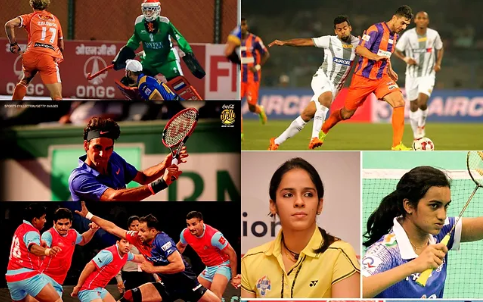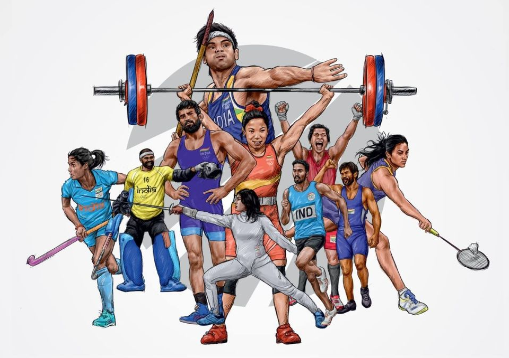India is a country that has always been passionate about sports. When we think of sports in India, cricket often comes to mind as the nation’s favorite pastime. People in India have a different obsession with cricket in their hearts. However, in recent years, there has been a noticeable shift in the sporting landscape as India’s interest in unconventional sporting events such as chess, javelin, hockey, and wrestling has grown exponentially. This change is not only diversifying India’s sporting culture but also providing athletes with the recognition and support they deserve.
The rise of non-mainstream sports in India

In recent years, there has been a notable shift in India’s sporting landscape, with a growing emphasis on alternative events. A new wave of alternative sports is capturing the imagination of Indian athletes and enthusiasts. Pragyananda’s achievements as a Grandmaster at a young age for chess, coupled with Neeraj Chopra’s historic gold medal win in the javelin throw at the Olympics, have garnered immense attention and admiration from the public.
Traditionally seen as a rural sport, wrestling has witnessed a resurgence in urban areas, with Indian wrestlers making their mark at global competitions.
Wrestlers like Sushil Kumar and Bajrang Punia have etched their names in history by winning medals at the Olympic Games and World Championships, proving that India is a force to be reckoned with in the world of wrestling. Furthermore, the rise of Indian athletes in sports like boxing, shooting, and weightlifting cannot be ignored. Boxers like Mary Kom and Vijender Singh have achieved great success in the ring and have become household names in India.
Similarly, shooters like Abhinav Bindra and Saurabh Chaudhary have displayed exceptional skills and precision, earning accolades and medals at prestigious events. Weightlifters like Mirabai Chanu and Saikhom Mirabai have shattered records and brought glory to the country in their respective weight categories. This change is not only diversifying India’s sporting culture but also providing athletes with the recognition and support they deserve.
Exploring the reasons behind the growing popularity of sports over cricket
One of the key factors contributing to this transformation is the increasing exposure and accessibility to a wide range of sporting events. With the advent of digital platforms and streaming services, Indians now have access to international tournaments and competitions across various sporting events. This exposure has opened doors to lesser-known sports and allowed enthusiasts to explore and appreciate diverse athletic disciplines.
Moreover, the success stories of Indian athletes in non-mainstream sports have played a pivotal role in driving this shift. With the rise of talented individuals like PV Sindhu in badminton, Mary Kom in boxing, Saina Nehwal in badminton, and Dipa Karmakar in gymnastics, the nation has witnessed firsthand the immense potential and skill in these lesser-known sports. Their achievements have inspired a new generation of athletes and sparked a surge in interest and participation in these disciplines.
Another significant factor contributing to the rise of non-mainstream sports is the growing support and investment from corporations and government bodies. Recognizing the untapped potential and the positive impact of sports on society, initiatives have been launched to promote and nurture talent in various sports. These efforts have not only provided financial support but have also created a much-needed infrastructure and training facilities, enabling athletes to excel and compete at international levels. This shift indicates a society that is becoming more open-minded, embracing diversity, and acknowledging the value of all athletic pursuits.
The role of media in shaping sports culture in India
The media plays a significant role in shaping sports culture in India. Over the years, the coverage and portrayal of different sports have influenced the popularity and perception of various games among the Indian audience. Traditionally, cricket has been the dominant sport in India, capturing the hearts and minds of millions. The media has played a crucial role in promoting and glamorizing cricket, making it more than just a sport.
Media coverage has not only increased the visibility of these sports but has also helped to change the perception of sports culture in India. It has brought attention to the struggles faced by athletes in non-cricketing sports, shedding light on their achievements and inspiring the younger generation to take up these sports.
Furthermore, the media’s coverage of international sporting events like the Olympics and the Commonwealth Games has played a crucial role in developing a broader sports culture in India. The success stories of Indian athletes on these global platforms have been widely covered, generating a sense of national pride and encouraging the youth to participate in various sports.
The rise of other sports in India can also be attributed to the emergence of leagues and tournaments specifically designed for these sports. Pro Kabaddi League, Premier Badminton League, and Indian Super League are just a few examples of successful leagues that have garnered immense popularity and brought these sports into the limelight.
Such leagues have not only provided a platform for athletes to showcase their skills but have also created a sense of pride and belonging for fans. In conclusion, the role of media and digital platforms in breaking the traditional barriers and promoting non-mainstream sports in India cannot be underestimated.
Conclusion
In conclusion, our exploration of the rise of non-mainstream sports in India has revealed a significant paradigm shift in mass interest. This shift signifies a broader change in societal attitudes towards sports and the recognition that there is room for various other sports to coexist and thrive. It is a testament to the fact that the Indian sporting culture is evolving, becoming more inclusive, and embracing the unique talents and passions of its people.
This inclusivity helps foster a sense of belonging and encourages individuals to pursue their passion, regardless of the popularity or recognition associated with a particular sporting event. It opens doors for international recognition and the opportunity to compete at a global level.
KASHISH CHHOTI
MUST READ: SK CHILDREN FOUNDATION: PIONEERS OF QUALITY STANDARDS AWARENESS


